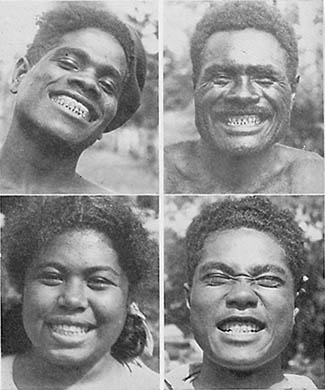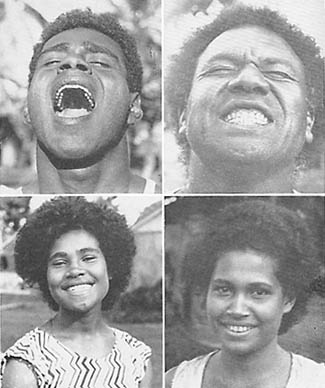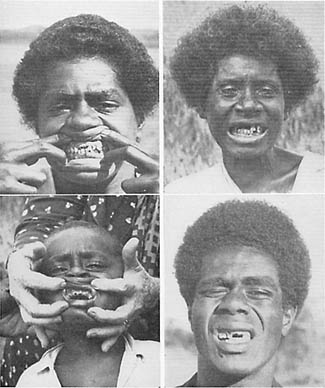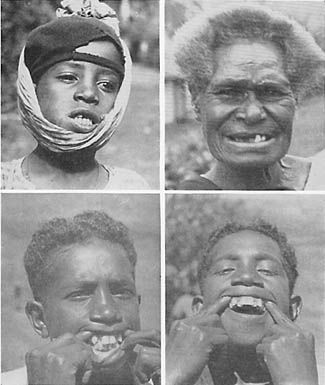
Isolated and modernized Melanesians
SINCE our quest was to gather data that will throw light upon the cause of modern physical degeneration among human racial stocks in various parts of the world, it became necessary to include for study various groups living in the hot sultry climates of the tropics. Again it was desirable to obtain contact with both highly isolated and, therefore, relatively primitive stocks for comparison with modernized groups of the same stock. In order to accomplish this an expedition was made in 1934 to eight archipelagos of the Southern Pacific to study groups of Melanesians and Polynesians. The Melanesians described here were living in New Caledonia and the Fiji Islands.
If the causative factors for the physical degeneration of mankind are practically the same everywhere, it should be possible to find a common cause operating, regardless of climate, race, or environment.
Owing to the vast extent of the Pacific waters and the limited number of transportation lines, it became very difficult to arrange a convenient itinerary. This, however, was finally accomplished satisfactorily by going southward through the more easterly archipelagos; namely, the Marquesas Islands, Society Islands and Cook Islands, then westward to the Tongan Islands in the southern central Pacific near New Zealand, and then westward to New Caledonia near Australia. From this group we went northward to the Fiji Islands, also in the western Pacific, then to the Samoan Islands in the central Pacific south of the equator, and then to the Hawaiian Islands north of the equator. These island groups were all populated by different racial stocks speaking different languages. The movements from archipelago to archipelago were made on the larger ships, and between the islands of the group in small crafts, except in the Hawaiian Islands where an aeroplane was used.
The program in each group consisted in making contact with local guides and interpreters. They had generally been arranged for in advance by correspondence with government officials. By these means we were able to reach isolated groups in locations quite distant from contact with trade or merchant ships. To reach these isolated groups often required going over rough and difficult trails since most of the islands being of volcanic formation are mountainous.

On reaching the isolated groups our greetings and the purpose of the mission were conveyed by our interpreters to the chiefs. Much time was often lost in going through necessary ceremonials and feasting. In every instance we received a very cordial reception and excellent cooperation. In no instance was there antagonism. Through the underground telegraph they always seemed to know we were coming and had prepared for us. When these formalities were once over and our wishes made known, the chiefs instructed the members of their tribes to carry out our program for making examinations, recording personal data, making photographs, and collecting samples of foods for chemical analysis. The food samples were either dried or preserved in formalin.
The detailed records for every individual included data on the tribe, village and family, his age, previous residence, physical development, the kinds of foods eaten, the physical condition of every tooth, including presence or absence of cavities; the shape of the dental arches; the shape and development of the face; and detailed notes on divergencies from racial type. Special physical characteristics were photographed. A comparsion was made of these factors for each of the more isolated members of the same tribe and those in the vicinity of the port or landing place of the island. Through the government officials detailed information was secured, usually in the form of the annual government statistical reports, showing the kind and quantity of the various ingredients and articles that were imported, and similarly those that were exported. Contact was made in each island group with the health officers, and the studies were usually made with their assistance. In many instances the only contact with civilization had consisted of the call of a small trading ship once or twice a year to gather up the copra or dried coconut, sea shells and such other products as the natives had accumulated for exchange. Payment for these products was usually made in trade goods and not in money. The following articles consisted nearly always of 90 per cent of the total value: white flour and sugar. Ten per cent consisted of wearing apparel or material for that apparel.
While the missionaries have encouraged the people to adopt habits of modern civilization, in the isolated districts the tribes were not able to depart much from their native foods because of the infrequency of the call of the trader ship. Effort had been made in almost all of the islands to induce the natives to cover their bodies, especially when in sight of strangers. In several islands regulatory measures had been adopted requiring the covering of the body. This regulation had greatly reduced the primitive practice of coating the surface of the body with coconut oil, which had the effect of absorbing the ultra-violet rays thus preventing injury from the tropical sun. This coating of oil enabled them to shed the rain which was frequently torrential though of short duration. The irradiation of the coconut oil was considered by the natives to provide, in addition, an important source of nutrition. Their newly acquired wet garments became a serious menace to the comfort and health of the wearers.
The early navigators who visited these South Sea Islands reported the people as being exceedingly strong, vigorously built, beautiful in body and kindly disposed. There were formerly dense populations on most of the inhabitable islands. In contrast with this, one now finds that on many of the islands the death rate has come to so far exceed the birth rate that the very existence of these racial groups is often seriously threatened.
The Island of New Caledonia is one of the largest of the Pacific. It is situated in the vicinity of 23 degrees south latitude and 165 degrees east longitude. The New Caledonians are pure Melanesian stock. They are broad shouldererd, very muscular and in the past have been very warlike. These Islands are under French control. The foreign population is chiefly French, and limited mainly to the vicinity of the one port of Noumea. The subjugation of these people has been very difficult and as recently as 1917 a band from the interior in protest against efforts to establish a white colony and sugar plantation on a desirable section of coastal land swept down on the French colony in the night and massacred almost the entire population. Their contact with the required foods from the sea had been cut off. They believe they require sea foods to maintain life and physical efficiency. The physical development of the primitive people including their teeth and dental arches is of very high order. A comparison of the individuals living near the ports with those living in the isolated inland locations shows marked increase in the incidence of dental caries. For those living almost exclusively on the native foods the incidence of dental caries was only 0.14 per cent; while for those using trade foods the incidence of dental caries was 26 per cent. The splendid facial and dental arch development of these quite primitive Caledonians is shown in Fig. 28. Note also their kinky hair and strong neck and face muscles.

The Fiji Island group lies between 15 and 22 degrees south latitude and between 177 degrees west and 175 degrees east longitude, thus straddling the international date line. The Fiji Islanders are similar in physical development and appearance to the New Caledonians, and like them are largely, if not wholly, Melanesian in racial origin. The men have kinky hair and broad shoulders. In the past, they have been excellent warriors. They are not as tall as their hereditary enemies, the Tongans, to the east, and in order to make themselves look equally tall, they have adopted the practice of training their kinky hair straight out from the head to a height often reaching six or more inches. Typical facial and dental arch forms are shown in Fig. 29. They are British subjects, and where they have had supervision, in the districts near the ports and on those islands on which sugar plantations have been established, they have suffered very greatly from the degenerative diseases.

Since Viti Levu, one of the islands of this group, is one of the larger islands of the Pacific Ocean, I had hoped to find on it a district far enough from the sea to make it necessary for the natives to have lived entirely on land foods. Accordingly, with the assistance of the government officials and by using a recently opened government road I was able to get well into the interior of the island by motor vehicle, and from this point to proceed farther inland on foot with two guides. I was not able, however, to get beyond the piles of sea shells which had been carried into the interior. My guide told me that it had always been essential, as it is today, for the people of the interior to obtain some food from the sea, and that even during the times of most bitter warfare between the inland or hill tribes and the coast tribes, those of the interior would bring down during the night choice plant foods from the mountain areas and place them in caches and return the following night and obtain the sea foods that had been placed in those depositories by the shore tribes. The individuals who carried these foods were never molested, not even during active warfare. He told me further that they require food from the sea at least every three months, even to this day. This was a matter of keen interest, and at the same time disappointment since one of the purposes of the expedition to the South Seas was to find, if possible, plants or fruits which together, without the use of animal products, were capable of providing all of the requirements of the body for growth and for maintenance of good health and a high state of physical efficiency. Among the sources of animal foods was the wild pig from the bush. These were not native, but imported into nearly all of the islands, and they have become wild where there is an abundance of food for them. Another animal food was that from coconut crabs which grow to a weight of several pounds. At certain seasons of the year the crabs migrate to the sea in great numbers from the mountains and interior country. They spend about three days in the sea for part of their reproductive program and return later to their mountain habitats. Their routes of travel are as nearly as possible in straight lines. At the season of migration, large numbers of the crabs are captured for food. These crabs rob the coconut trees of fruit. They climb the trees during the darkness and return to the ground before the dawn. They cut off the coconuts and allow them to drop to the ground. When the natives hear coconuts dropping in the night they put a girdle of grass around the tree fifteen or twenty feet from the ground, and when the crabs back down and touch the grass they think that they are down on the ground, let go their hold and are stunned by the fall. The natives then collect the crabs and put them in a pen where they are fed on shredded coconut. In two weeks' time the crabs are so fat that they burst their shells. They are then very delicious eating. Fresh water fish of various kinds are used where available from the mountain streams. Land animal foods, however, are not abundant in the mountainous interior, and no places were found where the native plant foods were not supplemented by sea foods.
Our first visit to the Fiji Islands was in 1934, and the second in 1936. On our first trip we had much personal assistance from Ratu Popi, hereditary king. His residence was on the royal island reserved exclusively for the king and his retinue. His picture is shown in Fig. 30 with that of Mrs. Price. He was very solicitous for the welfare of his people whom he recognized to be rapidly breaking down with modernization. The council house is also shown in Fig. 30. He gave us very important information regarding the origin of cannibalism, relating it to a recognition of special food values of special organs, particularly the livers.

There has been a very extensive development of sugar plantations on the larger islands of several of the Pacific archipelagos. The working of these plantations has required the importation of large numbers of indentured laborers. These have been brought chiefly from India and China. Since they are nearly all men, those who have married have obtained their wives from among the natives. This, the Chinese have done quite frequently. Since they are excellent workers they provide good homes and are good business men. They are, in many districts, rapidly becoming the landowners and are men of influence. This influx of Asiatics, together with that of Europeans, has had an important influence upon the purity of the native race around the ports and provided an opportunity to study the effect of intermingling of races upon the susceptibility to dental caries. No differences in extent of tooth decay due to ancestry were disclosed. The incidence of dental caries at the points of contact with imported foods was 30.1 per cent of teeth examined as compared with 0.42 for the more isolated groups living on the native foods of land and sea.
The physical changes which were found associated with the use of the imported foods included the loss of immunity to dental caries in practically all of the individuals who had displaced their native foods very largely with the modern foods. Dental caries was much worse, however, in the growing children and motherhood group due to the special demands of these individuals. These conditions are illustrated in Figs. 31 and 32. The boy shown in Fig. 32 (upper, left) typifies the suffering brought by modernization. Abscessed teeth often cause suicide.


Another important phase of the studies included a critical examination of the facial form and shape of the dental arches which include very definite and typical changes represented by the narrowing of the features and the lengthening of the face with crowding of the teeth in the arch. These are illustrated in the lower half of Fig. 32.
The members of the Melanesian race living on the Fiji Islands of the Pacific, whether volcanic or coral in origin, have developed a very high immunity to dental caries and well formed faces and dental arches. Their native foods consisted of animal life from the sea eaten with plants and fruits from the land in accordance with a definite program of food selection. In their primitive state only 0.42 per cent of their teeth were attacked by tooth decay. In the modernized groups this incidence increased to 30.1 per cent. The change in the nutrition included a marked reduction in the native foods and their displacement with white-flour products, sugar and sweetened goods, canned foods and polished rice. In the succeeding generations after the parents had adopted the modern foods, there occurred distinct change in facial form and shape of the dental arches.
Next
Table of Contents
Back to the Small Farms Library